Two New Ions: ASUS AT3N7A-I and ASRock Ion 330
by Anand Lal Shimpi on August 28, 2009 12:00 AM EST- Posted in
- Motherboards
The first companies to support non-Intel products are those that have the weakest relationships with Intel. How Intel is able to ensure this is the crux of the AMD v. Intel antitrust suit, but that’s not the point of today’s story.
NVIDIA’s Ion platform, at least when first introduced, combined Intel’s Atom CPU with NVIDIA’s GeForce 9300/9400M integrated graphics chipset. This offered better performance and modern features compared to Intel’s 945G chipset, what Intel was bundling with Atom. Intel still sold the CPUs but it lost the chipset sale and got upstaged by NVIDIA. Intel doesn’t like being upstaged by anyone.
Intel’s partners are very cautious when supporting a product like Ion. They don’t want to appear too eager and thus Intel’s closest partners wait to see if a product like Ion succeeds before attempting to jump on the bandwagon.
Zotac built the first mini-ITX Ion motherboard. While Zotac builds several Intel motherboards, they are hardly considered a tier 1 motherboard manufacturer. Zotac doesn’t get preferential treatment by Intel and thus Zotac doesn’t have to worry about ruffling any feathers by releasing an Ion motherboard.
I can’t tell you how well the Zotac Ion has sold, but reading our review and user experiences with the board I can tell you that customers are pleased. It’s a good product and it fills a niche that Intel currently has no answer to. I’m not even sure if Pine Trail will address that market either.
ASUS was Intel’s launch partner for Atom. The first place you found the Atom processor was in ASUS’ Eee PC and Eee Box. The rest of the OEMs followed. It’s no surprise that ASUS didn’t build an Ion motherboard or an Ion netbook for that matter.
ASUS tested the waters with its value manufacturing brand earlier this year. ASRock put out an Ion system based on the Intel Atom 330 processor; note the use of the word system. The ASRock Ion differed from the Zotac Ion motherboard in that it was a barebones system complete with mini-ITX chassis, external power supply, 2GB of RAM, slim optical drive and 320GB hard drive. All you needed to add was an OS.
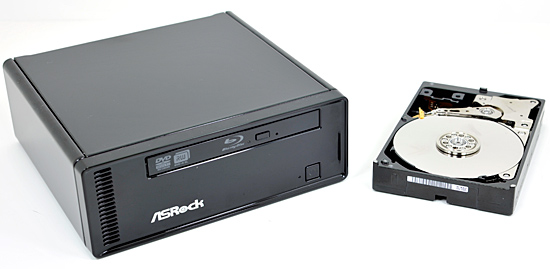
The ASRock Ion 330 (left) vs. a 3.5" HDD (right). We're not too far away from having P4-class PCs in the space of a hard drive.
The whole package sets you back $379.99 (ASRock does charge a slight premium for building the thing).
A couple of weeks ago we got word that the second mini-ITX Ion motherboard was coming our way. The manufacturer? ASUS. Ballsy.
Unlike the ASRock and Zotac Ion solutions, ASUS gave its Ion board a real and unnecessarily complex name. This is the AT3N7A-I:

Also gone is the North American favorite “Rock Solid, Heart Touching” phrase on the box. Instead we’re given two new slogans: Inspiring Innovation, Persistent Perfection (hooray for alliteration) and Perfectly suit your digital lifestyle.
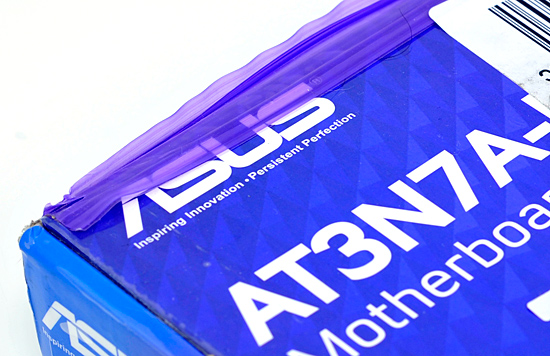
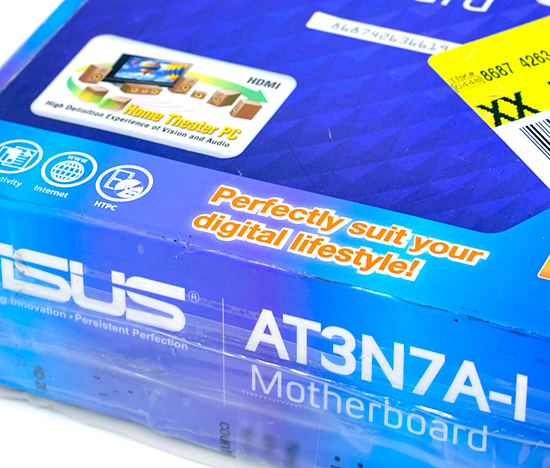
A Closer Look at the ASUS AT3N7A-I
ASUS’ Ion board doesn’t come with a power supply, it instead has a 24-pin ATX power supply connector and a 4-pin 12V connector for CPU power. The ASUS Ion is eerily similar to the Zotac board but with poorer color choices.
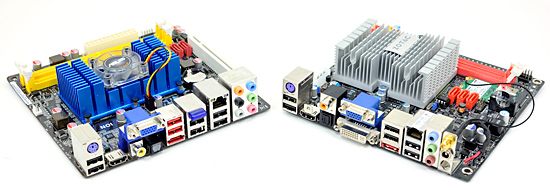
Zotac’s board has on-board WiFi, while ASUS’ board has on-board Bluetooth.

ASUS (left) vs. Zotac (right)
ASUS adds a ton more USB ports on the rear of the AT3N7A-I. You get a total of 8 USB ports (+2 more via an internal header), a single PS2 port, HDMI out, VGA out, coax/optical out, eSATA, Ethernet and the standard array of six 1/8” jacks for analog audio out.
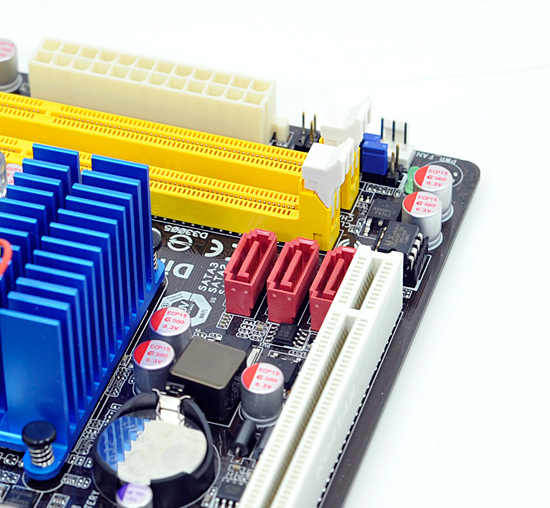
On the board itself there are three SATA ports, like the Zotac board, but ASUS also adds a standard 32-bit PCI slot (not PCIe).
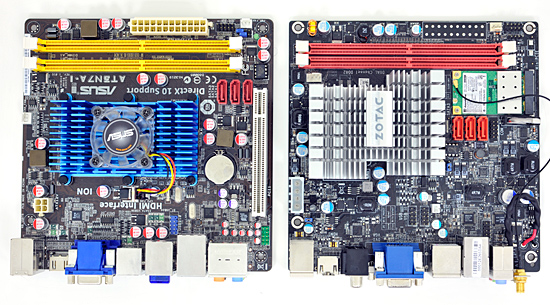
ASUS (left) vs. Zotac (right)
Two DIMM slots round out the package.










61 Comments
View All Comments
jwinckelmann - Sunday, September 13, 2009 - link
Hi,at least here in Germany the AT3N7A-I is officially sold with the noisy 6000 RPM fan. Totally unacceptable...
Bye,
Jan
nachtgeist - Sunday, September 6, 2009 - link
Very usefull rewiev, but i don't understand where is diffenrent between Asus and Zotac board for the 20% power consum diffenrent.Asus Express gate looks very good. But the power consum and noise fan is terrible.
When is poblem? Same CPU, same Chipsets and Asus takes 19W(?) more.
Abby - Wednesday, September 2, 2009 - link
A thousand Thaanks on effort writing this article and all the troubleshooting and also all the great help on sending bck faulty reports on behalf of us.Your enthusiasm on technology and service were greatly appreciated.
Thanks again.
best regards,
Abby
THG S**Ks hard~!
Shadowmaster625 - Tuesday, September 1, 2009 - link
Why not just use a celeron E1400 for $40, and maybe even overclock it?And yes, I would still trust my $50 ebay P4 865g system over one of these things. 166MHz FSB isnt just stupid, its like a sick joke.
deegee - Tuesday, September 1, 2009 - link
> Why not just use a celeron E1400The Atom CPU's lower power is the point of these.
You can also purchase the ITX boards with socket LGA775 or AM2 if you want a faster processor, but at a major increase in power use.
> I would still trust my $50 ebay P4
Trust? These are the same components as found on ATX boards, just a smaller form factor at 17cm x 17cm. ITX is designed for smaller size and lower power. Compare it to like buying a Mac Mini.
> 166MHz FSB
The Atom units are 533 FSB. Look at the "Rated FSB" value on CPUZ. The Bus Speed will be 1/2 for a two-way and 1/4 for a 4-way interleaved memory system. The regular ATX systems are the same for their FSB. You may wish to dl a copy of CPUZ and run it on your own system to see what the numbers mean.
deegee - Tuesday, September 1, 2009 - link
Sorry, fingers working faster than brain and no post edit... :-)DDR = double data rate, so 133 clock = 266 DDR freq, 2x interleave = 533 FSB, if I recall.
deegee - Tuesday, September 1, 2009 - link
I've been using an Atom PC for my surfing system for quite some time now. It has the Intel 945GCLF2D, 2GB RAM, Kingston 64GB SSDnow, in an Apex MI-008 case. On sale all the parts cost me about $300CDN. The case is 8.5"W x 12.5"D x 5"H (just slightly larger than an APC ES750W brick UPS), supports 2x 3.5" and 1x 5.25", and includes a 250W internal PS. It would work for a HS or HTPC since you could fit an SSD OS drive, a 1-2TB HD, and a DVD.I pulled the noisy fan off of the mobo and put a Noctua 80mm fan with the silencer connector (970RPM) blowing across the board from case vent-to-vent. It's so quiet you can hardly tell the system is on (it's half as loud as just a 3.5" HD's noise). The CPU runs at 25C, mobo at 40C. Temps go up by only ~5C under full load in Everest etc.
I'm running Windows 7RC and Kubuntu on it. Ubuntu (Gnome) is just too slow on the video. KDE performs not bad. But W7RC in Aero performs well, even on the GMA950. It is not as fast as my C2D or C2Q workstations of course, but it does ok for surfing. I also have a HS and HTPC but both of those are using C2D ATX, I personally wouldn't use an Atom for those since I prefer more performance, but for general surfing and a low-power system that I can leave on for downloading I don't care.
I'll probably upgrade the mobo sometime in the future to get the better video. I really recommend the small size and low noise of the Atom.
lordmetroid - Monday, August 31, 2009 - link
I want to build a server/HTPC combo, thing is it will have to be in my home and I can't get proper rest with a fan humming in the background.I was thinking, would it be possible to build a completely fanless system using the IONITX-C-U? Using an SSD and the external power brick would give me a system without any moving parts. But what kind of temperatures would such a system generate?
snarfies - Monday, August 31, 2009 - link
Asus and Asrock have repeated the exact same mistake that prevented me from considering the Zotac - Only three drive connectors. My MiniITX file server requires four: One for the SD Card reader, one for the optical drive, and two for the RAID1. The only Ion-based board that I know to support four drives is the Point of View Ion 330.strikeback03 - Monday, August 31, 2009 - link
There are USB headers that can be used for a card reader